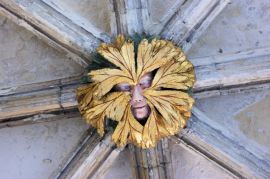This is a lightly reworked version of a post I wrote for The International Routier blog, which was published on March 1, 2012.
Now you have all your new-found board game skills worked out, what do you do with them? Get one of these to play on, obviously.

There’s Morris on the B side and backgammon inside. Here’s another example.

https://www.bayerisches-nationalmuseum.de/en/collection/00030454
Another variation is to have Glückshaus instead of Morris. And there are entire sites devoted to them. The Bavarian National Museum has a few. Obviously the flash sets are for the nobs, but let’s have another, closer look at the one the soldiers were playing draughts on from the post a few back. You can plainly see the division between the two layers of the board and the two catches holding them closed.
So there were plainer ones around for the plebs, just very few of them make it in to the history books or on display in museums. There’s an earlier backgammon board from the Mary Rose (1545) made in a similar way but without the B-sides for the other games, the two leaves of the board look like they have been made by different people and really obviously don’t match. The quality of the work is similar to the one in the painting. The other remarkable thing is that the veneer, particularly on the German ones, is as thin as modern knife-cut veneer, not medieval sawn veneer. You can see it in the corners where it’s lifting on this one in the Rochford Antique Chess Collection.
Often they were carried in a cloth or leather bag to protect them. The Mary Rose one had traces of red cloth on the outside, and there’s a couple of inventories from the 16th century specifying white leather bags.
So now there’s no excuse not to get a board or two. I’m going to have a crack at making one and might let you know how I go.
References
Bavarian National Museum. Spielkasten für Glückshaus, Schach und Trick-Track. (n.d.). Retrieved from https://www.bayerisches-nationalmuseum.de/en/collection/00033166
Contents of Rochford Antique Chess Collection. Retrieved from https://www.chessantiquesonline.com/rochford_collection/purple.html
Humphrey, N | Victoria and Albert Museum (2015). Printed Sources for a South German Games Board in V&A Online Journal Issue No. 7 Summer 2015, ISSN 2043-667X. Retrieved from http://www.vam.ac.uk/content/journals/research-journal/issue-no.-7-autumn-2015/printed-sources-for-a-south-german-games-board/
Gardiner, J., & Allen, M. J. (Eds.). (2003). Before the mast : life and death aboard the Mary Rose / edited by Julie Gardiner with Michael J. Allen ; with contributions from Mary-Anne Alburger [and 53 others]. Mary Rose Trust.

